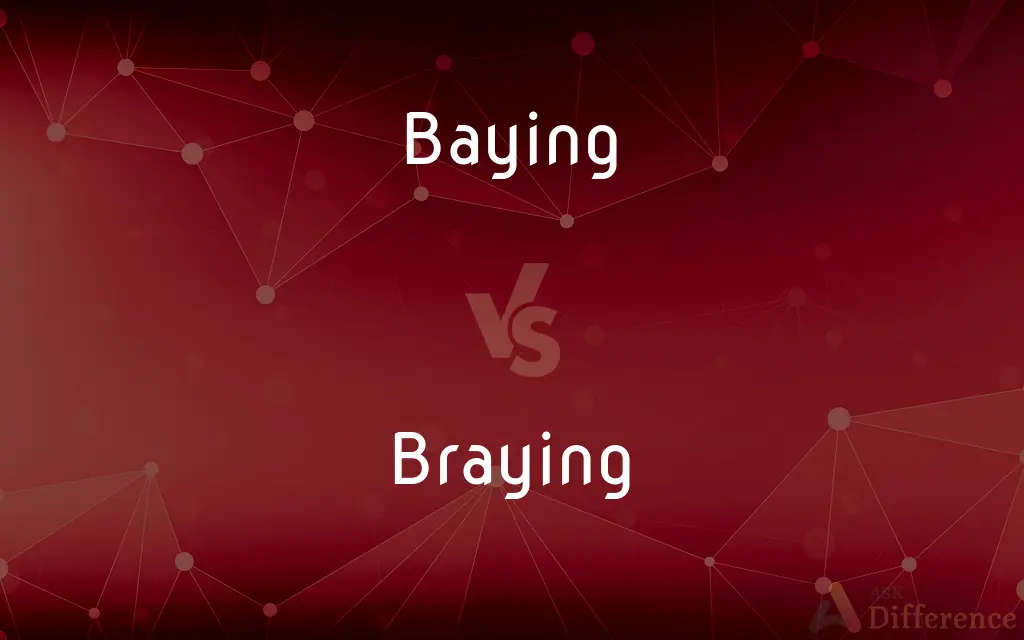Baying vs. Braying — What's the Difference?
By Urooj Arif & Fiza Rafique — Updated on March 19, 2024
Baying is the deep, prolonged howl of a hound, while braying is the loud, harsh sound made by a donkey.

Difference Between Baying and Braying
Table of Contents
ADVERTISEMENT
Key Differences
Baying is a vocalization characteristic of certain dog breeds, particularly hounds, used during hunting to signal the pursuit or cornering of prey. It's a deep, resonant sound that carries over long distances, often associated with the excitement of the chase. Braying, on the other hand, is the distinctive call of donkeys and mules, recognizable by its loud, coarse, and somewhat abrasive quality, usually consisting of a sharp inhalation followed by a prolonged exhalation.
The purpose of baying in dogs serves not only as a form of communication among the pack during a hunt but also to alert hunters to the location of the dog and the prey. Braying in donkeys is used for communication as well, signaling their presence to other donkeys, expressing distress, discomfort, or asserting dominance within a group.
Culturally, baying is often associated with the tradition of hunting with packs of hounds, evoking images of rural landscapes and the companionship between humans and dogs in the pursuit of game. Braying, however, is more closely tied to agricultural life, symbolizing the role of donkeys as working animals and their close association with human livelihoods, especially in rural and farming communities.
While baying is generally considered a harmonious and even musical sound by those who appreciate hunting and hound breeds, braying is often described with less affection, sometimes used metaphorically to describe unpleasant vocal expressions in humans. Despite these cultural perceptions, both sounds are essential forms of animal communication, reflecting the diverse ways in which different species express themselves and interact with their environments.
The auditory experience of baying and braying differs markedly, with baying embodying a deep, melodic tone that can be sustained over lengthy periods, whereas braying is characterized by its abrupt, loud, and distinctive nature, making it unmistakable but not necessarily melodious. Both sounds, however, play significant roles in the social behaviors of their respective animals, facilitating interaction, signaling distress, or coordinating activities within groups.
ADVERTISEMENT
Comparison Chart
Source
Hounds and other dog breeds
Donkeys and mules
Sound Characteristics
Deep, prolonged howl
Loud, harsh cry
Purpose
Communication during hunting, signaling pursuit of prey
Communication, distress signal, asserting dominance
Cultural Association
Hunting traditions, rural landscapes
Agricultural life, working animal symbol
Perception
Often viewed as harmonious or musical
Sometimes viewed as unpleasant or abrasive
Compare with Definitions
Baying
Used in hunting to communicate with hunters and other dogs.
The lead hound's baying signaled the chase was on.
Braying
Serves as a means of communication among donkeys and can signal various moods.
Her donkey's braying often indicated it was mealtime.
Baying
Associated with traditional hunting and the bond between hunter and hound.
The sound of baying at dawn is a familiar part of rural life.
Braying
Tied to the donkey's role in agriculture and as a beast of burden.
The braying of donkeys is a common sound in rural villages.
Baying
The deep, prolonged howl of a dog, especially a hound.
The baying of the hounds echoed through the forest during the hunt.
Braying
The loud, harsh sound made by a donkey.
The donkey's braying could be heard across the farm every morning.
Baying
Deep and resonant, capable of carrying long distances.
The baying grew louder as the dogs neared their prey.
Braying
Often considered jarring or less pleasant than other animal calls.
The tourists found the donkey's braying amusing yet loud.
Baying
Can be seen as melodic or stirring, especially by enthusiasts.
To him, the baying of his hounds was the sweetest music.
Braying
Sharp and distinctive, with a sound that cuts through other noises.
Despite the distance, the braying was unmistakable.
Baying
A deep, prolonged bark, such as the sound made by hounds.
Braying
To utter the loud, harsh cry of a donkey.
Baying
The position of one cornered by pursuers and forced to turn and fight at close quarters
The hunters brought their quarry to bay.
Braying
To sound loudly and harshly
The foghorn brayed all night.
Baying
The position of having been checked or held at a distance
"He has seen the nuclear threat held at bay for 40 years" (Earl W. Foell).
Braying
To emit (an utterance or a sound) loudly and harshly.
Baying
To utter a deep, prolonged bark.
Braying
To crush and pound to a fine consistency, as in a mortar.
Baying
To pursue or challenge with barking
"I had rather be a dog, and bay the moon" (Shakespeare).
Braying
To spread (ink) thinly over a surface.
Baying
To express by barking or howling
A mob baying its fury.
Braying
The loud, harsh cry of a donkey.
Baying
To bring to bay
"too big for the dogs which tried to bay it" (William Faulkner).
Braying
A sound resembling that of a donkey
"an endless bray of pointless jocosity" (Louis Auchincloss).
Baying
Action of the verb to bay; howling.
She quickly grew weary of the beast's constant baying.
Braying
Present participle of bray
Baying
An instance of baying; a howl.
Braying
An act or sound of braying.
Braying
Making a harsh noise; blaring.
Common Curiosities
Is braying unique to donkeys?
Braying is characteristic of donkeys and mules but is most prominently associated with donkeys due to its distinctive sound.
Can the sound of baying or braying be modified?
The fundamental nature of baying and braying is instinctual and tied to each animal's vocal cords and anatomy, making significant modifications difficult.
Can baying or braying indicate the health or mood of the animal?
Yes, changes in the frequency, duration, or tone of baying or braying can reflect the animal's health, stress levels, or mood.
Why do hounds bay?
Hounds bay to communicate during hunting, signaling the pursuit or capture of prey to hunters and other dogs.
How do animals react to their own sounds?
Animals may respond to baying or braying as calls to action, signals of presence, or indicators of emotional states, facilitating interaction within species.
Why do donkeys bray?
Donkeys bray for communication, expressing a range of emotions from distress to calling out to other donkeys, or to assert dominance.
How do people respond to baying and braying?
Responses vary widely; some appreciate the sounds as part of nature or cultural heritage, while others may find them noisy or disturbing.
Are there benefits to the sounds of baying and braying?
Both sounds play crucial roles in animal communication, helping with the coordination of activities, expressing needs or warnings, and maintaining social hierarchies.
Can other dog breeds bay?
While baying is most associated with hounds, other dog breeds can produce similar sounds, especially if they're excited or in pursuit of something.
Is there any way to reduce excessive baying or braying?
Addressing the underlying cause, such as loneliness, boredom, or discomfort, can help reduce excessive vocalizations.
Share Your Discovery

Previous Comparison
Hellcat vs. Witch
Next Comparison
Designer vs. DeveloperAuthor Spotlight
Written by
Urooj ArifUrooj is a skilled content writer at Ask Difference, known for her exceptional ability to simplify complex topics into engaging and informative content. With a passion for research and a flair for clear, concise writing, she consistently delivers articles that resonate with our diverse audience.
Co-written by
Fiza RafiqueFiza Rafique is a skilled content writer at AskDifference.com, where she meticulously refines and enhances written pieces. Drawing from her vast editorial expertise, Fiza ensures clarity, accuracy, and precision in every article. Passionate about language, she continually seeks to elevate the quality of content for readers worldwide.













































